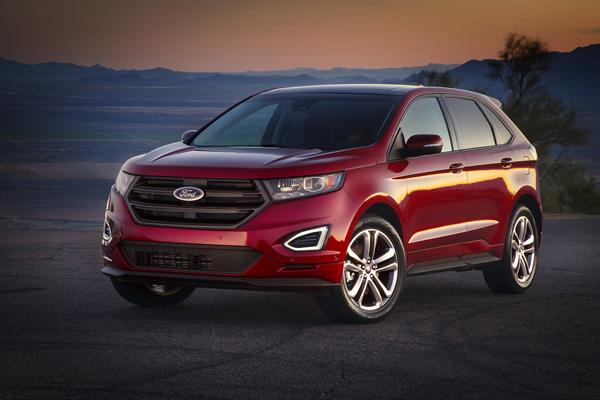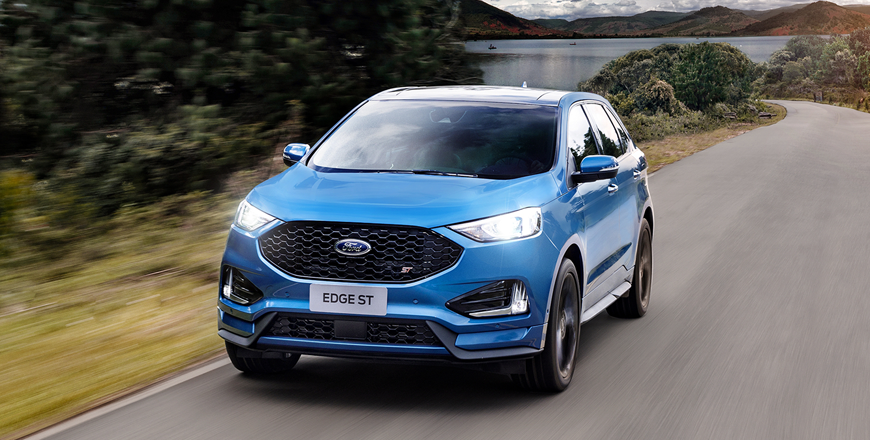You are here
Ford Edge Titanium: Comfortable, quick and convenient crossover
By Ghaith Madadha - Jul 27,2020 - Last updated at Jul 27,2020

Photo courtesy of Ford
First introduced in 2006 as the fashion for crossover SUVs was starting to gather momentum as a chunky and assertive compact to mid-size family vehicle, the Ford Edge made significant strides forward upon the launch of the second generation model by 2015. An impressive all-rounder with plenty of convenience and comfort combined with punchy engines and good handling properties in one of the less sporty automotive segments, the Edge now receives the customary mid-life revision, with refreshed looks, improved mechanicals and updated and new tech and safety features.
Winning the best Compact Crossover prize at the 2020 Middle East Car of the Year awards over its adventurously — and more controversially — styled Chevrolet Blazer rival, the Ford Edge’s tautly packaged and high waistline design receives four new colours and alloy wheel options, and more importantly, new bonnet and fascia designs, including a wider and classier looking new hexagonal grille. Launched in 2019, the face-lifted Edge is available in the Middle East in three trim lines sharing the same mechanicals, including the featured high spec Titanium model, plus a more powerful, sportier Edge ST variant.
Punchy and responsive
Tried and tested, the Edge’s powerful yet efficient turbocharged direct injection 2-litre four-cylinder Ecoboost engine has in different guises powered a broad range of different vehicles from the Ford Focus ST hot hatch to Jaguar luxury saloons and Land Rover SUVs. Developing 250BHP at 5,500rpm and 275lb/ft at 3,000rpm for service in the Ford Edge, the transversely-mounted 2-litre Ecoboost delivers perky and punchy performance. Carried over, the Edge’s engine is, however, mated to a new 8-speed automatic gearbox in lieu of an outgoing 6-speed dual clutch unit, for improved refinement, efficiency, flexibility and performance.
With its prodigious engine and new gearbox — with a broader and more versatile range of gear ratios — the Edge’s 0-100km/h time has been improved from somewhere in the low 8-second range to an estimated 7.6-seconds, despite marginal weight gain to 1,870kg. Responsive from idling and quick spooling, the Edge delivers plenty of mid-range muscle for overtaking and on-the-move acceleration, while power accumulation is confidently punchy and urgent, if not too obvious under its layers of cabin refinement. Fuel consumption is meanwhile restrained given the Edge’s weight, height and performance, and is estimated at 7.5l/100km on the combined cycle.
Tidy and forgiving
Slick, smooth and quick through gears, the Edge’s gearbox channels power primarily to the front wheels in most circumstances, but power is allocated to the rear wheels for additional traction and grip when needed over loose surfaces, through corners or in moderate off-road driving. Turning tidily into corners with unexpected agility and powering out responsively and confidently, the Ford Edge’s eager character makes it feel not too different than an oversized but willing hatchback. Light but quick, the Edge’s electric-assisted steering is direct, eager and delivers comparatively good road feel for its segment.
With a good compromise between ride and handling, the Edge is happy to be driven briskly through corners, and delivers good body control despite its forgiving and smooth comfort over imperfections, partly owing to its MacPherson front and integral-link rear suspension, which allows for a rigid lateral set-up along with supple vertical movements. Eager and willing when chucked into a corner, the Edge also delivers reassuring road holding. Stable at speed and sure-footed over rough highway patches, the Edge feels settled, and is well insulated from noise, harshness and vibrations, even with low profile 245/50R20 tyres.
Comfort and convenience
A smooth ride with settled rebound control, the Edge is meanwhile comfortable inside, with good front views from its hunkered down driver’s seat. With its steering set somewhat low and its seating slightly high within its hunkered down cabin, it takes a few moment to adjust to the Edge’s driving position, but once done, it is supportive, alert and ergonomic. The Edge meanwhile scores well on comfort and convenience, with lots of storage compartments, reclining rear seats, big door apertures for easy access, and a low loading height for its 1,111-litre generous boot.
Control and dash layouts are user-friendly, and now include a rotary-style gear selector, while infotainment, convenience, driver-assistance and safety features are generous across the range, and especially in Titanium specification, as driven. Included are standard post-collision braking, evasive steering assistance and active parking assistance with parallel and perpendicular functions. The Edge also features a split view 180° front monitor, pedestrian detection brake assistance, blind spot assistance, rear cross-traffic alert and lane departure warning. Titanium specification also receives a wireless charging pad, 12-speaker Bang and Olufsen sound system, remote start and leather seats with front heating and cooling.
TECHNICAL SPECIFICATIONS
Engine: 2.0-litre, turbocharged, transverse 4-cylinders
Bore x stroke: 87.5 x 83.1mm
Compression ratio: 10:1
Valve-train: 16-valve, DOHC, variable valve timing, direct injection
Gearbox: 8-speed automatic, four-wheel-drive
Ratios: 1st 4.69; 2nd 3.31; 3rd 3.01; 4th 1.92; 5th 1.45; 6th 1.0; 7th 0.75; 8th 0.62; R 2.96
Power, BHP (PS) [kW]: 250 (253.5) [186.4] @5,500rpm
Specific power: 125BHP/litre
Power-to-weight: 133.7BHP/ton (estimate)
Torque, lb/ft (Nm): 275 (373) @3,000rpm
Specific torque: 186.6Nm/litre
Torque-to-weight: 199.5Nm/ton (estimate)
0-100km/h: 7.6-seconds (estimate)
Fuel consumption, combined: 7.5-litres/100km
Length: 4,795mm
Width: 1,928mm
Height: 1,735mm
Wheelbase: 2,850mm
Track, F/R: 1,646/1,643mm
Headroom, F/R: 1,021/1,023mm
Legroom, F/R: 1,082/1,031mm
Shoulder room, F/R: 1,531/1,536mm
Hip room, F/R: 1,420/1,460mm
Lift-over height: 752mm
Luggage volume, behind 2nd/1st row, liquid, to roof: 1,111-/2,078-litres
Fuel capacity: 70-litres
Kerb weight: 1,870kg (estimate)
Steering: Electric-assisted rack and pinion
Turning circle: 12-metres (estimate)
Suspension, F/R: MacPherson strut/integral-link, coil springs, anti-roll bars
Brakes, F/R: Ventilated discs, 345 x 32mm/316 x 11mm
Tyres: 245/50R20
Related Articles
First launched in late 2006, the Ford Edge was the Blue Oval’s first foray into a then still somewhat nascent car-based compact SUV segment
Edging out the superb Ford Focus ST hot hatch as the iconic American manufacturer’s most compact performance vehicle in its home marke
Among the blue oval’s most iconic cars, the Ford Escort name has served multiple generations and even concurrent compact car lines during it














